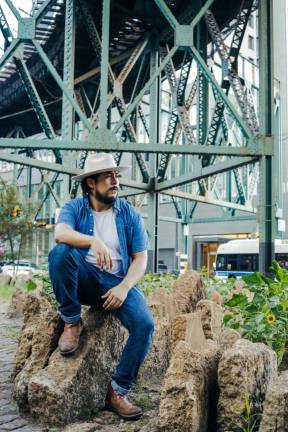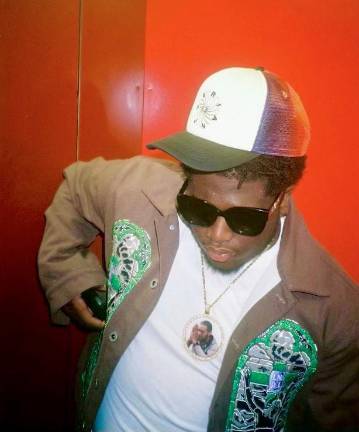The Strivers of Fall
How a young photographer and a new voice in hip-hop are making their mark in the city


Every morning just before sunrise, twenty-six-year-old barista, Sergio Reyes, gets out of bed in his East Harlem apartment, takes a shower and hops on the M15 bus to the Upper East Side café, Inès, where he fills eighty to a hundred cups of coffee throughout the day.
A mustached Manhattan native whose lifting of tables and hauling of trash mark his tirelessness, Reyes is one of the strivers of fall. Thankful to be working at a time in which the coronavirus still hobbles the city and unemployment is at 10.2 percent, he also pursues his art after hours like many other New Yorkers and embodies the city’s 24-7 vigor.
“I grew up in a very old-fashioned household where my dad always taught me the value of hard work and the idea that, if you’re going to do something, you should do it at your best,” Reyes says during a rare lull at the usually bustling Inès.
“For me, the whole idea is that hospitality is making sure people are well-received, making sure people feel that they’re welcome, part of the family and part of something,” he continues. “They’re part of a group, a collective. It’s not just a business per se; yeah, we’re selling coffee here and there but I always like to make people feel included, like they’re part of the shop.”
On most nights after making four to five pots of coffee and running to the café’s glass-walled veranda with trays of baguettes for hungry patrons, Reyes works on his photography. Often doing shoots with his co-worker and friend, the St. Lucia-born Joshua Popo, Reyes travels across the city to take both portraits and streetscapes that lend a glimmer to the dark of the pandemic.
“Being able to make people happy when they see themselves in the photographs [is my goal],” he says. “I rather capture a model in her essence in a New York City street where you see all of the chaos yet you see all of the beauty as well,” Reyes adds as the speaker above plays dance music, R&B and hip-hop.
Rap Underground
One of the most intriguing new voices in hip-hop and another striver is Cash Cobain. Hailing from the South Bronx and just twenty-three-years-old, the musician has been rapping for over ten years and been producing since childhood. Citing The Notorious B.I.G. as a main influence, Cobain has not only the warmth of the slain rapper but also his will to strive.
First appearing around the twelfth century, the word strive stems from the Old French term estriver which means “to put up a fight” or “compete.” Cobain, who has performed around Manhattan for the past several years and will next headline the hip-hop hotbed SOB’s, does just that; he is perhaps the fiercest beatmaker in New York’s rap underground.
Even as the coronavirus persists along with its subsequent joblessness crisis, Cobain has released several records, most recently “719” (Neva Slippin, 2021) and “Nirvana” (2021). Both albums fall within the rap subgenre of drill, which is not just a type of music, but which in its very sound echoes the jackhammers and drills that blare throughout the city.
What separates Cobain from many other gifted rappers is the soulfulness that he injects into his music. He is, in fact, one of the progenitors of the drill subgenre, soul drill, which comprises samples of older songs and infuses warmth into an otherwise harsh sound. Like the celebrated Florida rapper, Rod Wave, Cobain even sings over his beats.
On the festive song, “Casamigos,” from 719, for instance, he coos like a bruised lover, “I’ve been through so much damage,/Had a lot of plans.” The guitar-rolled “I Remember,” conversely, has him admitting his own mistakes as he croons, “I know I did you wrong in the past,/I’m sorry.”
Throughout “719” and “Nirvana,” however, the relentlessness of New York resounds. At the start of the drum-stuttered “Rider, Pt. 2 (feat. Rah Meezy),” off “719,” Cobain concedes, “Working for my daughter,/We’ll be like the Carters” while on the piano-tolled next track, “One More Time,” he sings with flagless ardor, “I’ll die for you, provide for you, ride for you.”
A core member of the New Jersey artist collective, MPHG Sound, who sometimes records in the studio, Cobain also works hard at home and creates a kind of bedroom rap. “My work ethic is going out and doing what I need to do,” he says by phone from his apartment, chopping vegetables on a hardboard as a television crackles. “It ain’t hard because I love doing what I do.”
Production schedules amongst rappers vary, with some artists releasing records every few years and still others more frequently, but Cobain works every day. “I get on my laptop and work on something, a beat, something,” he says. “This is the 9-9.”
From the uptown barista/photographer, Reyes, whose headphones will soon blast Cobain to the downtown smocked grocer who shouts, “Baby, I love you” into his phone after a long shift, strivers fill the city, and while the first chill of fall has arrived, their will endures.